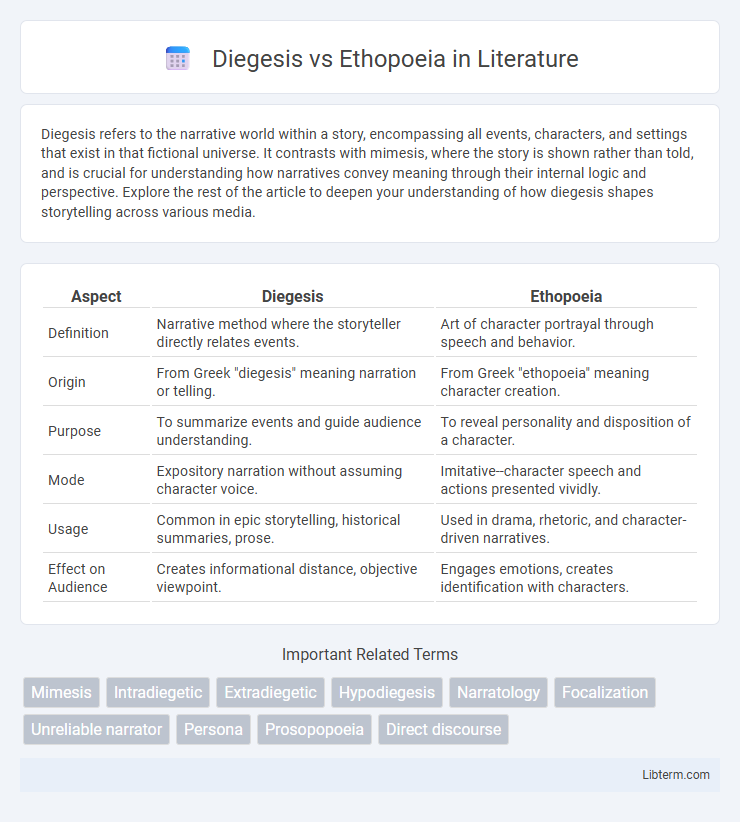Diegesis refers to the narrative world within a story, encompassing all events, characters, and settings that exist in that fictional universe. It contrasts with mimesis, where the story is shown rather than told, and is crucial for understanding how narratives convey meaning through their internal logic and perspective. Explore the rest of the article to deepen your understanding of how diegesis shapes storytelling across various media.
Table of Comparison
| Aspect | Diegesis | Ethopoeia |
|---|---|---|
| Definition | Narrative method where the storyteller directly relates events. | Art of character portrayal through speech and behavior. |
| Origin | From Greek "diegesis" meaning narration or telling. | From Greek "ethopoeia" meaning character creation. |
| Purpose | To summarize events and guide audience understanding. | To reveal personality and disposition of a character. |
| Mode | Expository narration without assuming character voice. | Imitative--character speech and actions presented vividly. |
| Usage | Common in epic storytelling, historical summaries, prose. | Used in drama, rhetoric, and character-driven narratives. |
| Effect on Audience | Creates informational distance, objective viewpoint. | Engages emotions, creates identification with characters. |
Introduction to Diegesis and Ethopoeia
Diegesis refers to the narrative mode in which a story is told by a narrator who describes events, characters, and settings directly, creating a comprehensive fictional world. Ethopoeia involves the imitation or representation of a character's speech and behavior, allowing the narrator or an actor to embody and convey the character's personality and emotions. Understanding the distinction between diegesis and ethopoeia is essential for analyzing storytelling techniques across literature, theater, and media.
Defining Diegesis: The Art of Storytelling
Diegesis refers to the narrative technique where the story is told through a narrator who describes events, characters, and settings, providing a comprehensive and immersive account. This method allows for detailed exposition and insight into characters' thoughts and events beyond immediate perception. In contrast to ethopoeia, which emphasizes character speech and actions, diegesis serves as the foundational art of storytelling by constructing the story's world through narrative description.
Understanding Ethopoeia: Crafting Character Voice
Ethopoeia involves the skilled imitation or creation of a character's voice and personality through narrative or dialogue, allowing writers to convey distinct psychological traits and emotional depth. This technique enhances storytelling by providing authentic expressions that reflect a character's thoughts, feelings, and motivations, making the narrative more immersive. Unlike diegesis, which simply relates events, ethopoeia actively shapes the character's identity through linguistic and stylistic choices.
Historical Origins of Diegesis and Ethopoeia
Diegesis originated in ancient Greek literature as a narrative technique where the storyteller directly describes events, contrasting with mimesis, which involves direct representation or imitation. Ethopoeia, also rooted in the classical tradition, specifically pertains to the art of character portrayal through speech and behavior, emphasizing the writer's or speaker's ability to evoke a persona. The historical development of diegesis and ethopoeia reflects foundational distinctions in rhetorical and literary theory regarding narration and character embodiment.
Diegesis in Literature and Narrative Structure
Diegesis in literature refers to the narrative technique where the story is told through a narrator who describes events, characters, and settings directly, creating a comprehensive and immersive fictional world. It shapes narrative structure by providing a cohesive framework that integrates the plot, character development, and thematic elements within a unified fictional universe. This approach allows readers to experience the story through detailed exposition, enriching the depth and complexity of the narrative.
Ethopoeia as a Rhetorical Device in Classical Texts
Ethopoeia, a key rhetorical device in classical texts, involves the vivid portrayal of a character's emotions, intentions, and personality through crafted speech or narration, enhancing persuasive impact and audience engagement. This technique contrasts with diegesis, which presents events and narratives through direct storytelling rather than immersive character embodiment. Classical rhetoricians like Aristotle and Cicero emphasized ethopoeia for its ability to evoke ethos and pathos, making arguments more compelling by aligning the speaker's character with the message conveyed.
Key Differences Between Diegesis and Ethopoeia
Diegesis involves the narrative technique where the storyteller recounts events directly to the audience, emphasizing exposition and description, while ethopoeia centers on the rhetorical imitation or portrayal of a character's speech or behavior to convey emotions and personality. Key differences include diegesis operating predominantly through third-person narration or summary, whereas ethopoeia requires the speaker's enactment or embodiment of another's voice to create vivid character presence. Diegesis builds the overall story framework, whereas ethopoeia enhances character depth and persuasive appeal through expressive performance.
Examples of Diegesis and Ethopoeia in Modern Media
Diegesis in modern media is exemplified by documentaries like "The Social Dilemma," where the narrative is directly told through interviews and voiceovers, creating a clear storytelling framework. Ethopoeia appears in character-driven series such as "Breaking Bad," where Walter White's moral transformation is conveyed through his speech and actions, embodying his evolving personality and ethical dilemmas. These examples highlight how diegesis delivers the story through explicit narration, while ethopoeia uses character expression to convey meaning implicitly.
The Impact of Diegesis and Ethopoeia on Reader Engagement
Diegesis shapes reader engagement by immersing audiences in a narrated world, providing detailed contextual information that deepens understanding and emotional investment. Ethopoeia drives engagement through character voice and perspective, allowing readers to connect intimately with personalities and motives, enhancing empathy and narrative immersion. Together, diegesis and ethopoeia balance world-building and character psychology, maximizing reader involvement and cognitive resonance within the story.
Conclusion: Integrating Diegesis and Ethopoeia in Creative Writing
Integrating diegesis and ethopoeia in creative writing enriches narrative depth by combining direct storytelling with character-driven speech. Diegesis provides the overarching plot framework, while ethopoeia breathes life into characters through personalized voice and emotion. Balancing these techniques enhances reader engagement and fosters a multidimensional narrative experience.
Diegesis Infographic

 libterm.com
libterm.com